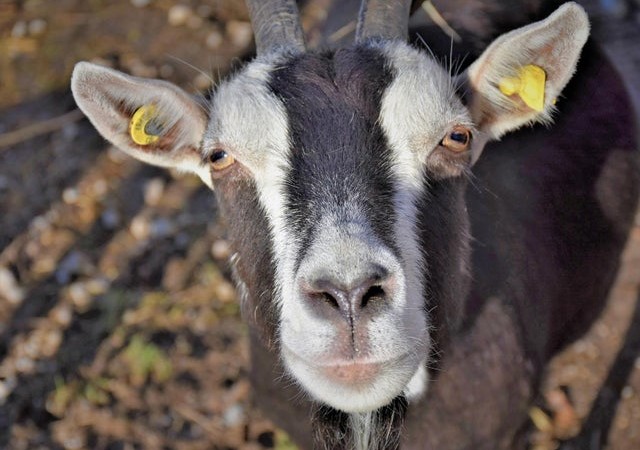

Sight
Goats have a similar blind spot at rear just like sheep, but they are more difficult to catch using this area as they are generally more alert than sheep. They can distinguish different colours , responding best to orange and worst to blue.
Goat eyes focus well on distant or middle-distant objects, but sometimes goats need a little help distinguishing motionless individuals from afar, especially people, who frequently change the color and shape of clothing. Gentle movement and a call can help your goats to recognize you at a distance. Goats eyes pick up light ranging from the violet/blue through green to yellow/orange part of the spectrum due to two types of color receptors in their retina, called cones. One type is most sensitive to blue light, while the other to green. Humans have an additional cone type that is sensitive to red light, so that we can distinguish red as a separate color from green and yellow. Most color-blind humans and many mammals, including goats, cannot see the difference between red and green which may appear similar to yellow.
Hearing
Goats can hear a wider range and much higher pitches than humans (goats: 70 Hz to 40 KHz; humans: 31 Hz to 17 KHz). They often become alert to sounds that we cannot hear. They may become disturbed or distressed by sounds such as the high frequency squeaks of electric machinery and metal devices, many of which are imperceptible to us. Sudden, loud, or high-pitched sound, such as children’s screams and people’s laughter, can trigger an alarm response. This makes sense, as goats emit loud, high-pitched, shaky bleats when they are in trouble. Kids’ bleats are high-pitched to attract the urgent attention of their mother. Aggressive bleats are harsh and deep.
Locating sound is not as accurate in goats as it is in humans, so they swivel their ears to pinpoint the direction of each noise. A wary goat, listening out for danger, can often be seen with ears pointing in different directions. Sound is also used in communication between herd members. There are gentle bleats used simply to maintain contact: quiet, steady, low-pitched, and often delivered with the mouth closed. Dams mutter to their kids in this way. You can emulate these gentle sounds to keep your goats calm during handling.
Smell
Goats’ great sense of smell also plays an important role in feeding, avoiding predators, and social activities. The damp skin on their noses and inside their nostrils has many more sensors than humans have. They identify and choose food from its smell. Moreover, they navigate a sensory world that is hard for us to imagine, guided by messages left behind by other animals in odor form. Mothers bond with their young initially by learning their unique scent. Visual and vocal recognition follow soon after.
Pheromones in goats’ saliva, urine, and scent glands are unique to each individual and give information about a goat’s identity, sex, health, sexual receptivity, and possibly emotion. Scent glands are located behind the horns, under the tail, and between the front toes.
 Contact Jaguza Support
Contact Jaguza Support